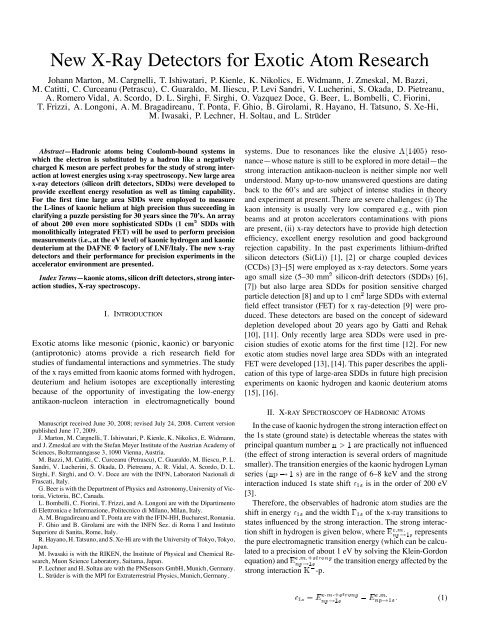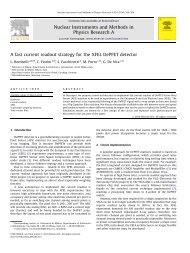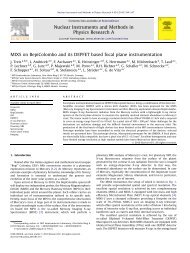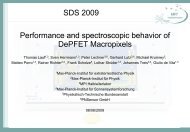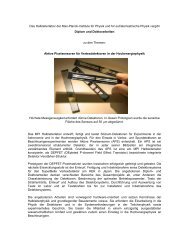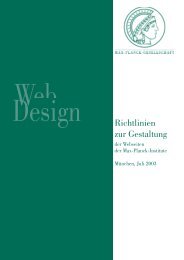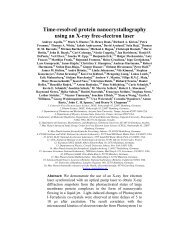New X-Ray Detectors for Exotic Atom Research - MPG HLL
New X-Ray Detectors for Exotic Atom Research - MPG HLL
New X-Ray Detectors for Exotic Atom Research - MPG HLL
Create successful ePaper yourself
Turn your PDF publications into a flip-book with our unique Google optimized e-Paper software.
<strong>New</strong> X-<strong>Ray</strong> <strong>Detectors</strong> <strong>for</strong> <strong>Exotic</strong> <strong>Atom</strong> <strong>Research</strong><br />
Johann Marton, M. Cargnelli, T. Ishiwatari, P. Kienle, K. Nikolics, E. Widmann, J. Zmeskal, M. Bazzi,<br />
M. Catitti, C. Curceanu (Petrascu), C. Guaraldo, M. Iliescu, P. Levi Sandri, V. Lucherini, S. Okada, D. Pietreanu,<br />
A. Romero Vidal, A. Scordo, D. L. Sirghi, F. Sirghi, O. Vazquez Doce, G. Beer, L. Bombelli, C. Fiorini,<br />
T. Frizzi, A. Longoni, A. M. Bragadireanu, T. Ponta, F. Ghio, B. Girolami, R. Hayano, H. Tatsuno, S. Xe-Hi,<br />
M. Iwasaki, P. Lechner, H. Soltau, and L. Strüder<br />
Abstract—Hadronic atoms being Coulomb-bound systems in<br />
which the electron is substituted by a hadron like a negatively<br />
charged K meson are perfect probes <strong>for</strong> the study of strong interaction<br />
at lowest energies using x-ray spectroscopy. <strong>New</strong> large area<br />
x-ray detectors (silicon drift detectors, SDDs) were developed to<br />
provide excellent energy resolution as well as timing capability.<br />
For the first time large area SDDs were employed to measure<br />
the L-lines of kaonic helium at high precision thus succeeding in<br />
clarifying a puzzle persisting <strong>for</strong> 30 years since the 70’s. An array<br />
of about 200 even more sophisticated SDDs (1 cm SDDs with<br />
monolithically integrated FET) will be used to per<strong>for</strong>m precision<br />
measurements (i.e., at the eV level) of kaonic hydrogen and kaonic<br />
deuterium at the DAFNE factory of LNF/Italy. The new x-ray<br />
detectors and their per<strong>for</strong>mance <strong>for</strong> precision experiments in the<br />
accelerator environment are presented.<br />
Index Terms—kaonic atoms, silicon drift detectors, strong interaction<br />
studies, X-ray spectroscopy.<br />
I. INTRODUCTION<br />
<strong>Exotic</strong> atoms like mesonic (pionic, kaonic) or baryonic<br />
(antiprotonic) atoms provide a rich research field <strong>for</strong><br />
studies of fundamental interactions and symmetries. The study<br />
of the x rays emitted from kaonic atoms <strong>for</strong>med with hydrogen,<br />
deuterium and helium isotopes are exceptionally interesting<br />
because of the opportunity of investigating the low-energy<br />
antikaon-nucleon interaction in electromagnetically bound<br />
Manuscript received June 30, 2008; revised July 24, 2008. Current version<br />
published June 17, 2009.<br />
J. Marton, M. Cargnelli, T. Ishiwatari, P. Kienle, K. Nikolics, E. Widmann,<br />
and J. Zmeskal are with the Stefan Meyer Institute of the Austrian Academy of<br />
Sciences, Boltzmanngasse 3, 1090 Vienna, Austria.<br />
M. Bazzi, M. Catitti, C. Curceanu (Petrascu), C. Guaraldo, M. Iliescu, P. L.<br />
Sandri, V. Lucherini, S. Okada, D. Pietreanu, A. R. Vidal, A. Scordo, D. L.<br />
Sirghi, F. Sirghi, and O. V. Doce are with the INFN, Laboratori Nazionali di<br />
Frascati, Italy.<br />
G. Beer is with the Department of Physics and Astronomy, University of Victoria,<br />
Victoria, BC, Canada.<br />
L. Bombelli, C. Fiorini, T. Frizzi, and A. Longoni are with the Dipartimento<br />
di Elettronica e In<strong>for</strong>mazione, Politecnico di Milano, Milan, Italy.<br />
A. M. Bragadireanu and T. Ponta are with the IFIN-HH, Bucharest, Romania.<br />
F. Ghio and B. Girolami are with the INFN Sez. di Roma I and Instituto<br />
Superiore di Sanita, Rome, Italy.<br />
R. Hayano, H. Tatsuno, and S. Xe-Hi are with the University of Tokyo, Tokyo,<br />
Japan.<br />
M. Iwasaki is with the RIKEN, the Institute of Physical and Chemical <strong>Research</strong>,<br />
Muon Science Laboratory, Saitama, Japan.<br />
P. Lechner and H. Soltau are with the PNSensors GmbH, Munich, Germany.<br />
L. Strüder is with the MPI <strong>for</strong> Extraterrestrial Physics, Munich, Germany.<br />
systems. Due to resonances like the elusive resonance—whose<br />
nature is still to be explored in more detail—the<br />
strong interaction antikaon-nucleon is neither simple nor well<br />
understood. Many up-to-now unanswered questions are dating<br />
back to the 60’s and are subject of intense studies in theory<br />
and experiment at present. There are severe challenges: (i) The<br />
kaon intensity is usually very low compared e.g., with pion<br />
beams and at proton accelerators contaminations with pions<br />
are present, (ii) x-ray detectors have to provide high detection<br />
efficiency, excellent energy resolution and good background<br />
rejection capability. In the past experiments lithium-drifted<br />
silicon detectors (Si(Li)) [1], [2] or charge coupled devices<br />
(CCDs) [3]–[5] were employed as x-ray detectors. Some years<br />
ago small size (5–30 mm silicon-drift detectors (SDDs) [6],<br />
[7]) but also large area SDDs <strong>for</strong> position sensitive charged<br />
particle detection [8] and up to 1 cm large SDDs with external<br />
field effect transistor (FET) <strong>for</strong> x ray-detection [9] were produced.<br />
These detectors are based on the concept of sideward<br />
depletion developed about 20 years ago by Gatti and Rehak<br />
[10], [11]. Only recently large area SDDs were used in precision<br />
studies of exotic atoms <strong>for</strong> the first time [12]. For new<br />
exotic atom studies novel large area SDDs with an integrated<br />
FET were developed [13], [14]. This paper describes the application<br />
of this type of large-area SDDs in future high precision<br />
experiments on kaonic hydrogen and kaonic deuterium atoms<br />
[15], [16].<br />
II. X-RAY SPECTROSCOPY OF HADRONIC ATOMS<br />
In the case of kaonic hydrogen the strong interaction effect on<br />
the 1s state (ground state) is detectable whereas the states with<br />
principal quantum number are practically not influenced<br />
(the effect of strong interaction is several orders of magnitude<br />
smaller). The transition energies of the kaonic hydrogen Lyman<br />
series s are in the range of 6–8 keV and the strong<br />
interaction induced 1s state shift is in the order of 200 eV<br />
[3].<br />
There<strong>for</strong>e, the observables of hadronic atom studies are the<br />
shift in energy and the width of the x-ray transitions to<br />
states influenced by the strong interaction. The strong interaction<br />
shift in hydrogen is given below, where represents<br />
the pure electromagnetic transition energy (which can be calculated<br />
to a precision of about 1 eV by solving the Klein-Gordon<br />
equation) and<br />
the transition energy affected by the<br />
strong interaction -p.<br />
(1)
2 / 5<br />
TABLE I<br />
THE PROPERTIES OF KAONIC HYDROGEN AND KAONIC DEUTERIUM ATOMS<br />
ARE SHOWN. THE VALUES AND OF KAONIC DEUTERIUM ACCORDING<br />
TO RECENT THEORETICAL STUDIES ARE GIVEN.<br />
TABLE II<br />
PROPERTIES OF X-RAY DETECTORS USED FOR EXOTIC ATOM RESEARCH:<br />
LITHIUM DRIFTED SILICON SI(LI) DETECTOR, CCDS (TYPE CCD-55 USED IN<br />
KAONIC ATOM RESEARCH BY DEAR) AND LARGE AREA SDDS (THIS WORK).<br />
Fig. 1. The last stages of the electromagnetic transitions in kaonic hydrogen<br />
are governed by x-ray transitions. Since only the 1s state is shifted due to the<br />
strong interaction antikaon-nucleon from the energy of the Lyman transitions<br />
( , ) the strong interaction shift can be determined by the deviation<br />
from the pure electromagnetic transition energies.<br />
Especially interesting systems are kaonic hydrogen and<br />
kaonic deuterium atoms since they are the most simple kaonic<br />
systems well accessible by theory. From the strong interaction<br />
shift and width values of both systems the isospin-dependent<br />
antikaon-nucleon scattering lengths can be extracted in a fairly<br />
model independent way [17].<br />
A. The Scientific Case: Kaonic Hydrogen and Helium Isotopes<br />
In the following Table I the properties of simple kaonic atoms<br />
are given. The required precision of the shift and width measurements<br />
is at the level of percent corresponding to a precision level<br />
of a few eV. According to the experience of the DEAR experiment<br />
[3] even more important is the background rejection.<br />
B. SDDs: <strong>New</strong> X-ray <strong>Detectors</strong> With Timing Capability<br />
The electrons produced by an x-ray hit on a SDD are radially<br />
drifting toward the anode in the center of the device. The<br />
drift field is provided by concentric electrodes on one side. The<br />
anode size itself is very small and independent of the detector<br />
area. There<strong>for</strong>e, one can produce large area SDDs with still<br />
small detector capacitance and good energy resolution. In addition,<br />
the small anode area makes it possible to reduce the<br />
active layer thickness, while the capacitance is small. A thin<br />
active layer reduces the continuum background caused by the<br />
Compton process. There are 2 types of large area SDDs: (i)<br />
SDDs with external first amplification transistor and (ii) SDDs<br />
with the integration of the first amplification transistor (FET)<br />
on chip. The first type was used in the experiment on kaonic<br />
helium-4 [12] whereas the second type was developed <strong>for</strong> the<br />
SIDDHARTA (Silicon Drift <strong>Detectors</strong> <strong>for</strong> Hadronic <strong>Atom</strong> <strong>Research</strong><br />
by Timing Application) experiment [19] on kaonic hydrogen/deuterium.<br />
1) Design <strong>for</strong> <strong>Exotic</strong> <strong>Atom</strong> <strong>Research</strong>: Silicon drift detectors<br />
<strong>for</strong> exotic atom research have to fulfill the following requirements<br />
(i) timing capability with sufficient time resolution<br />
s to suppress the asynchronous background efficiently,<br />
(ii) high efficiency close to 100% up to about 15 keV due to<br />
Fig. 2. Front side of the SDDs developed <strong>for</strong> the SIDDHARTA experiment.<br />
3 SDDs with an active area (rounded quare) of 100 mm each are arranged on<br />
one chip (A). Picture B shows the center of a SDD with the integrated transistor.<br />
Picture C shows 2 SDD chips (2 3 SDDs) with ceramics and connector cables<br />
mounted.<br />
the sensitive layer thickness<br />
, (iii) energy resolution<br />
in the order of 150 eV at 6 keV (achievable with cooling<br />
to ) to allow the precise extraction of the position and<br />
width of theKlines, (iv) low noise due to the small anode with<br />
low capacitance, (v) short shaping time s <strong>for</strong> high detection<br />
rate capability, (vi) low internal electromagnetic background<br />
compared with thicker (crystal) detectors, (vii) good energy<br />
separation<br />
between minimum ionizing particles<br />
and photons, (viii) compact design <strong>for</strong> arrangements in<br />
x-ray detector arrays.<br />
In order to fulfill these requirements new large area SDDs<br />
were developed <strong>for</strong> the SIDDHARTA experiment. The work<br />
was done within a Joint-<strong>Research</strong>-Activity (JRA10) of the<br />
Integrated Infrastructure Activity HadronPhysics of the 6th<br />
framework of the European Community. These SDDs were<br />
designed and produced by the Max-Planck Institute <strong>for</strong> Extraterrestic<br />
Physics together with PNsensor Munich. The<br />
bonding and glueing were per<strong>for</strong>med by the Fraunhofer Institute<br />
Berlin. Finally SMI/Vienna was responsible <strong>for</strong> the SDD<br />
testing and assembling. In Fig. 2 details of the SIDDHARTA
3 / 5<br />
TABLE I<br />
THE PROPERTIES OF KAONIC HYDROGEN AND KAONIC DEUTERIUM ATOMS<br />
ARE SHOWN. THE VALUES AND OF KAONIC DEUTERIUM ACCORDING<br />
TO RECENT THEORETICAL STUDIES ARE GIVEN.<br />
TABLE II<br />
PROPERTIES OF X-RAY DETECTORS USED FOR EXOTIC ATOM RESEARCH:<br />
LITHIUM DRIFTED SILICON SI(LI) DETECTOR, CCDS (TYPE CCD-55 USED IN<br />
KAONIC ATOM RESEARCH BY DEAR) AND LARGE AREA SDDS (THIS WORK).<br />
Fig. 1. The last stages of the electromagnetic transitions in kaonic hydrogen<br />
are governed by x-ray transitions. Since only the 1s state is shifted due to the<br />
strong interaction antikaon-nucleon from the energy of the Lyman transitions<br />
( , ) the strong interaction shift can be determined by the deviation<br />
from the pure electromagnetic transition energies.<br />
Especially interesting systems are kaonic hydrogen and<br />
kaonic deuterium atoms since they are the most simple kaonic<br />
systems well accessible by theory. From the strong interaction<br />
shift and width values of both systems the isospin-dependent<br />
antikaon-nucleon scattering lengths can be extracted in a fairly<br />
model independent way [17].<br />
A. The Scientific Case: Kaonic Hydrogen and Helium Isotopes<br />
In the following Table I the properties of simple kaonic atoms<br />
are given. The required precision of the shift and width measurements<br />
is at the level of percent corresponding to a precision level<br />
of a few eV. According to the experience of the DEAR experiment<br />
[3] even more important is the background rejection.<br />
B. SDDs: <strong>New</strong> X-ray <strong>Detectors</strong> With Timing Capability<br />
The electrons produced by an x-ray hit on a SDD are radially<br />
drifting toward the anode in the center of the device. The<br />
drift field is provided by concentric electrodes on one side. The<br />
anode size itself is very small and independent of the detector<br />
area. There<strong>for</strong>e, one can produce large area SDDs with still<br />
small detector capacitance and good energy resolution. In addition,<br />
the small anode area makes it possible to reduce the<br />
active layer thickness, while the capacitance is small. A thin<br />
active layer reduces the continuum background caused by the<br />
Compton process. There are 2 types of large area SDDs: (i)<br />
SDDs with external first amplification transistor and (ii) SDDs<br />
with the integration of the first amplification transistor (FET)<br />
on chip. The first type was used in the experiment on kaonic<br />
helium-4 [12] whereas the second type was developed <strong>for</strong> the<br />
SIDDHARTA (Silicon Drift <strong>Detectors</strong> <strong>for</strong> Hadronic <strong>Atom</strong> <strong>Research</strong><br />
by Timing Application) experiment [19] on kaonic hydrogen/deuterium.<br />
1) Design <strong>for</strong> <strong>Exotic</strong> <strong>Atom</strong> <strong>Research</strong>: Silicon drift detectors<br />
<strong>for</strong> exotic atom research have to fulfill the following requirements<br />
(i) timing capability with sufficient time resolution<br />
s to suppress the asynchronous background efficiently,<br />
(ii) high efficiency close to 100% up to about 15 keV due to<br />
Fig. 2. Front side of the SDDs developed <strong>for</strong> the SIDDHARTA experiment.<br />
3 SDDs with an active area (rounded quare) of 100 mm each are arranged on<br />
one chip (A). Picture B shows the center of a SDD with the integrated transistor.<br />
Picture C shows 2 SDD chips (2 3 SDDs) with ceramics and connector cables<br />
mounted.<br />
the sensitive layer thickness<br />
, (iii) energy resolution<br />
in the order of 150 eV at 6 keV (achievable with cooling<br />
to ) to allow the precise extraction of the position and<br />
width of theKlines, (iv) low noise due to the small anode with<br />
low capacitance, (v) short shaping time s <strong>for</strong> high detection<br />
rate capability, (vi) low internal electromagnetic background<br />
compared with thicker (crystal) detectors, (vii) good energy<br />
separation<br />
between minimum ionizing particles<br />
and photons, (viii) compact design <strong>for</strong> arrangements in<br />
x-ray detector arrays.<br />
In order to fulfill these requirements new large area SDDs<br />
were developed <strong>for</strong> the SIDDHARTA experiment. The work<br />
was done within a Joint-<strong>Research</strong>-Activity (JRA10) of the<br />
Integrated Infrastructure Activity HadronPhysics of the 6th<br />
framework of the European Community. These SDDs were<br />
designed and produced by the Max-Planck Institute <strong>for</strong> Extraterrestic<br />
Physics together with PNsensor Munich. The<br />
bonding and glueing were per<strong>for</strong>med by the Fraunhofer Institute<br />
Berlin. Finally SMI/Vienna was responsible <strong>for</strong> the SDD<br />
testing and assembling. In Fig. 2 details of the SIDDHARTA
4 / 5<br />
Fig. 8. Energy spectrum of the Lyman transitions in kaonic hydrogen (background<br />
components are removed) resulting from the DEAR experiment [3].<br />
Fig. 6. Foto of the Day-1 setup of SIDDHARTA showing the cryogenic gas<br />
target cell and the array of SDDs.<br />
Fig. 9. Monte Carlo simulation of the energy spectrum of kaonic hydrogen to<br />
be measured by the SIDDHARTA experiment. Compared with the DEAR experiment<br />
the SIDDHARTA experiment will improve the signal-to-background<br />
ratio by more than 2 orders of magnitude. This simulation <strong>for</strong> SIDDHARTA was<br />
per<strong>for</strong>med with an anticipated 5:1 signal-to-background ratio.<br />
Fig. 7. In SIDDHARTA a triple coincidence will be applied <strong>for</strong> background<br />
suppression (top). The light-weight crygenic gas target cell (bottom left) will be<br />
surrounded by the SDD array (bottom right).<br />
emitted charged kaon pair and the x ray is used <strong>for</strong> the suppression<br />
of uncorrelated background events (see Fig. 7). Cryogenic<br />
nitrogen is used as target gas filling because of the high x-ray<br />
yield. The kaonic nitrogen x-ray transitions first measured by<br />
the DEAR experiment will be used to study the background suppression<br />
as well as the energy resolution.<br />
In Fig. 7 below the main parts of the SIDDHARTA setup<br />
are displayed. The cryogenic hydrogen gas target consists of<br />
an aluminum grid structure with thin Kapton windows.<br />
The target will be operated at a temperature of 22 K and a<br />
working pressure of 2.5 bar. Up to 216 SDDs ordered in subunits<br />
will surround the cryogenic gas cell. The final setup of SID-<br />
DHARTA will be mounted in 2008. At the highest priority in<br />
the SIDDHARTA experiment are precision measurements of the<br />
x-ray spectra (K transitions) of kaonic hydrogen and kaonic deuterium<br />
[27]–[31]. An integrated luminosity of about 400<br />
is planned to be used in the kaonic hydrogen measurement.<br />
The precision of the DEAR experiment was mainly limited<br />
by the poor signal-to-background ratio (1:100).<br />
This problem will be overcome with the SIDDHARTA setup.<br />
Monte-Carlo simulations show the excellent per<strong>for</strong>mance of<br />
SIDDHARTA (see Fig. 9)—in the case of kaonic hydrogen a<br />
signal-to-background ratio of 5:1 is the goal of this experiment.<br />
In the more difficult case of kaonic deuterium (the x-ray yield<br />
is by far lower, see Table I) a signal-to-noise ratio of 1:1 is<br />
anticipated.<br />
From the measured shift and width of the 1s state in kaonic<br />
hydrogen and deuterium the isospin-dependent scattering<br />
lengths can be extracted with unprecedented accuracy. <strong>New</strong><br />
experimental in<strong>for</strong>mation about the kaon-proton interaction<br />
at threshold and the resonance—important <strong>for</strong> the<br />
research on deeply bound kaonic systems—will be provided.<br />
III. SUMMARY<br />
The potential of new x-ray detectors <strong>for</strong> exotic atom research<br />
was shown in an experiment at KEK <strong>for</strong> the first time. The
5 / 5<br />
research on kaonic atoms provides insight in the low-energy antikaon-nucleon<br />
interaction. Long-standing puzzles were solved<br />
but precision experiments are highly requested to provide<br />
high quality data <strong>for</strong> a clear decision on different theoretical<br />
approaches. <strong>New</strong> experiments with large area SDDs are in<br />
preparation at LNF and at J-PARC. <strong>New</strong> x-ray detectors were<br />
developed which are anticipated to reach the goal of a precision<br />
in the eV range—thus a breakthrough in the antikaon physics<br />
at lowest energies is within reach.<br />
ACKNOWLEDGMENT<br />
This work is partly supported by the EU within Joint <strong>Research</strong><br />
Activity 10 of I3-HadronPhysics and Transnational Access to<br />
<strong>Research</strong> Infrastructures Contract No.:RII3-CT-2004-506078.<br />
Gratefully acknowledged is the important contribution to the<br />
electronics by Giovanni Corradi and Diego Tagnani from LNF-<br />
INFN.<br />
REFERENCES<br />
[1] M. Iwasaki et al., Phys. Rev. Lett., vol. 78, p. 3067, 1997.<br />
[2] T. M. Ito et al., Phys. Rev., vol. 58, p. 2366, 1998.<br />
[3] G. Beer et al., Phys. Rev. Lett., vol. 94, p. 212302, 2005.<br />
[4] M. Cargnelli et al., Nucl. Instr. Meth. A, vol. 535, p. 389, 2004.<br />
[5] T. Ishiwatari et al., Nucl. Instr. and Meth. A, vol. 556, p. 509, 2006.<br />
[6] L. Strüder and H. Soltau, Radiation Protection Dosimetry, vol. 61, p.<br />
39, 1995.<br />
[7] P. Lechner et al., Nucl. Instr. and Meth. A, vol. 377, p. 346, 1996.<br />
[8] W. Chen, H. Kraner, Z. Li, P. Rehak, E. Gatti, A. Longoni, M. Sampietro,<br />
P. Holl, J. Kemmer, U. Faschingbauer, B. Schmitt, A. Woner, and<br />
J. P. Wurm, IEEE Trans. Nucl. Sci., vol. 39, pp. 619–628, Aug. 1992.<br />
[9] J. S. Iwanczyk, B. E. Patt, C. R. Tull, J. D. Segal, C. J. Kenney, J.<br />
Bradley, B. Hedman, and K. O. Hodgson, IEEE Trans. Nucl. Sci. vol.,<br />
vol. 46, pp. 284–288, Jun. 1999.<br />
[10] E. Gatti and P. Rehak, Nucl. Instr. and Meth. A, vol. 225, p. 608, 1984.<br />
[11] E. Gatti and P. Rehak, Nucl. Instr. Meth. A, vol. 541, p. 47, 2005.<br />
[12] S. Okada et al., Phys. Lett. B, vol. 653, pp. 387–391, 2007.<br />
[13] [Online]. Available: http://www.ketek.net<br />
[14] J. Marton, in Proceedings of International Symposium on Detector Development<br />
<strong>for</strong> Particle, Astroparticle and Synchrotron Radiation Experiments<br />
(SNIC 2006), Menlo Park, Cali<strong>for</strong>nia, Apr. 3–6, 2006, p.<br />
0196.<br />
[15] J. Marton, in Proc. Workshop on <strong>Exotic</strong> Hadronic <strong>Atom</strong>s, Deeply<br />
Boundkaonic Nuclear States and Antihydrogen: Present Results,<br />
Future Challenges, European Centre <strong>for</strong> Theoretical Nuclear Physics<br />
and Related Areas (ECT*), Trento, Italy, Jun. 19–24, 2006.<br />
[16] M. Cargnelli et al., Canadian Journal of Physics, vol. 85, p. 479, 2007.<br />
[17] U.-G. Meißner, U. Raha, and A. Rusetsky, Eur. Phys. J. C, vol. 35, p.<br />
349, 2004.<br />
[18] A. N. Ivanov et al., Eur. Phys. J. A, vol. 23, p. 79, 2005.<br />
[19] [Online]. Available: http://www.lnf.infn.it/esperimenti/siddharta<br />
[20] C. Fiorini and P. Lechner, IEEE Trans. on Nucl. Sci., vol. 46, no. 3, p.<br />
761, 1999.<br />
[21] C. Fiorini and P. Lechner, IEEE Trans. on Nucl. Sci., vol. 49, no. 3, p.<br />
1147, 1999.<br />
[22] C. E. Wiegand and R. H. Pehl, Pehl, Phys. Rev. Lett., vol. 27, p. 1410,<br />
1971.<br />
[23] C. J. Batty et al., Nucl. Phys. A, vol. 326, p. 455, 1979.<br />
[24] S. Baird et al., Nucl. Phys. A, vol. 392, p. 297, 1983.<br />
[25] C. J. Batty, Nucl Phys. A, vol. 508, p. 89c, 1990.<br />
[26] Y. Akaishi, Proceedings of EXA 05, A. Hirtl, J. Marton, E. Widmann,<br />
and J. Zmeskal, Eds. Vienna: Austrian Academy of Sciences Press,<br />
2005, p. 45.<br />
[27] J. Zmeskal et al., Proceedings of EXA 05, A. Hirtl, J. Marton, E. Widmann,<br />
and J. Zmeskal, Eds. Vienna: Austrian Academy of Sciences<br />
Press, 2005, p. 139.<br />
[28] M. Cargnelli et al., Int. J. Mod. Phys A, vol. 20, p. 341, 2005.<br />
[29] J. Marton, “Proc. XLV international winter meeting on nuclear<br />
physics,” in Ricerca Scientifica ed Educazione Permanente, Supp. N<br />
127, I. Iori and A. Tarantola, Eds. : Dipartimento di Fisica, Universita<br />
degli Studi di Milano, 2007, p. 85.<br />
[30] J. Marton et al., “Proc. XLVI winter meeting on nucl. Physics,” in<br />
Ricerca Scientifica ed Educazione Permanente N.129, I. Iori and A.<br />
Tarantola, Eds. : Dipartimento di Fisica, Universita degli Studi di Milano,<br />
2008, p. 121.<br />
[31] C. Curceanu (Petrascu) et al., EPJA, vol. 31, pp. 537–539, 2007.


